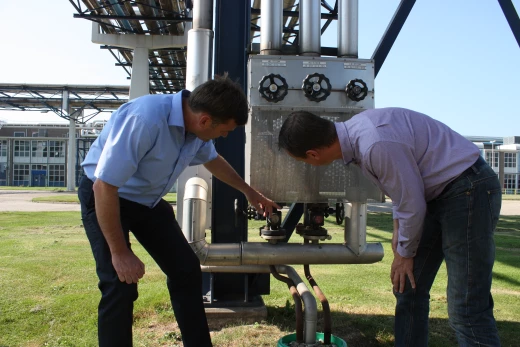
|
Rotterdam
KLINGER The NetherlandsNikkelstraat 2 3067 GR Rotterdam
Elsloo
KLINGER Service Center LimburgBusiness Park Stein 208A 6181 MB Elsloo
Velsen-Noord
KLINGER The NetherlandsRooswijkweg 200 1951 MD Velsen-Noord
Moordrecht
Hadro TechnologySouth Lane 351 2841 MD Moordrecht |

Emmtec: Efficiency optimization through KLINGER steam traps
From corrective to preventive maintenance steam traps
Condense jars that were 2.5 times more expensive, but of much better quality and with a longer lifespan than the ones they had. With that forecast, Richard de Haan stepped up to management. "Invest in this, and we'll pay it back within a month." They went for it.
Anyone who works at Business Park Emmtec in Emmen, Drenthe, knows exactly who we are talking about. For they not only own and manage the infrastructure on the site, they are also the main provider of public utilities such as steam, electricity, various types of water, compressed air, nitrogen and natural gas. "Ever since 1954," begins Richard de Haan, asset manager Emmtec Service B.V. at Operations. "That stands for Industry Parc Operations," he explains.

Keep your standard valve!
Richard loves standard. Of standardizing, rather. "Because if you standardize, then you can control your work. That's conducive to quality. If we have to replace valves, we know exactly which ones to replace and how to do it. Because, in fact, we always use the same ones. That also benefits inventory management." For a long time, it was that different with steam traps. Those were anything but standardized. "It was a collection of all different steam traps, of different quality, with different individual parts. All those parts we had in stock, and so of all those pots we had to know how to maintain them."
At the customer, the meter starts running
And those steam traps, they're pretty crucial for delivering steam. Pipelines run from Emmtec to various companies on the site. Emmtec puts steam in it at the beginning of the pipeline, and the moment it reaches the customer, "the meter starts running. As it travels, the steam passes through several steam traps, in order to drain the condensate that is just below the saturated steam temperature. "The less condensate there is along the way, the less difference there is between what we put in and what comes out," he says. So a malfunction or failure in a condensate trap just means very simply loss of steam. That's a waste, not sustainable and it costs time and money."
Diversity defined the leadership picture
In short, the fewer failures, the cleaner the delivery. "But I noticed that we put in a lot more steam than came out the other end. Some loss is acceptable, then we're talking about about 5%. But often it was 6, or 7, and sometimes as much as 8%. I started to see where that could be due." He quickly arrived at the diversity of steam traps. "We had many different types of steam traps across the property, all of which also consisted of many separate parts. Moreover, they often needed to be repaired. In short: a lot of inventory, a lot of repair costs and a lot of loss of steam. Not exactly efficient."
Analysis, advice and proposal
So Marc, along with a team of fellow product specialists, came up with an analysis and a recommendation. "They made it clear what a leaking steam trap costs. And what it saves if we replace them." KLINGER made a proposal for replacing the steam traps. "About 2.5 times more expensive to buy than we were used to, but of much better quality. And better quality means less maintenance, which in turn means fewer safety risks." Richard pauses for a moment. "It's not just a steam pot. It's the pot, the research, the quality, the service and the implementation by KLINGER. They are not out to deliver quickly, but to provide a good solution. From head to tail. And that's when I say: that's what I'm getting!"

Solutions with benefits
Richard came into contact with Marc Westerhuis of KLINGER. "We actually never just supply a product. We do research, develop solutions and adapt a wide range of technical products accordingly," Marc explains. "So we don't just put a pallet of steam traps in the warehouse, we deliver a solution that benefits the company. Added value! If that added value isn't there, then we haven't done our job properly."
Instant results
And so we landed at the moment when Richard stepped up to the board, with the research and figures from KLINGER under his arm. It didn't take him long to convince them; it was immediately clear: an investment on the front end and profit on the back end. "On multiple levels. If we measure now, we have a 1.2% loss between entry and exit. That saves us tons! The 100 or so steam traps purchased - AB600 for high-pressure steam of 33 barg. 400 gr. and AB3000 for low-pressure steam 3 barg. 190 gr. - were delivered and installed in phases in 2014 and 2015. "Maintenance has dropped dramatically in cost and we need much less inventory. Before, the steam traps took up about 10 meters of wall, now one shelf."
It's about safety, and the overall picture
There are also gains in other areas. "Look, in the very first place with us is always safety. That remains indisputably number one. But after that it's about the overall picture. Buying the cheapest product is not always the cheapest solution. I'm not out to buy the cheapest, but to produce the cheapest. That's where the profit is."
Result belongs to all of us
As such, De Haan believes that delivering quality products is an integral task. "When procurement asks me, 'what is your budget?', I always say, 'your quote is my budget.' Because that's because I look at what it costs as well as what it delivers. I also don't look at budgets per department. If communication or procurement invests 10% of the budget, but it increases the operating result by 20%, then that result belongs to all of us, right?"
For more information about our steam solutions, please contact:
Demian Nouwens
Product Specialist Energy Management, Steam Solutions
